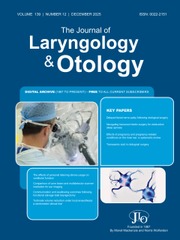Fractures of the temporal bone have been traditionally categorised as longitudinal, transverse or mixed.Reference Goligher and Lloyd1 The nomenclature has changed in recent years to a more functional division into ‘otic capsule sparing’ and ‘otic capsule violating’ fractures. This issue's ‘paper of the month’ is a paper from London Ontario, CanadaReference Algouneh, Madou, Gandhi, Paradis, Graham and Strychowsky2, describing 88 paediatric cases of temporal bone fracture, analysed in a retrospective study of a 13-year cohort of 369 children presenting with skull fractures to a tertiary hospital network. The last major series of temporal bone trauma reported in the Journal was a study of 188 adults from Korea in 2017, confined to otic capsule sparing fractures, which makes interesting reading to compare with the paediatric series.Reference Song, Jun and Kim3 The main cause of the trauma in these children was a fall from a height, contrasting with adult series in which motor vehicle accidents (road traffic collisions) were the dominant cause. The otic capsule was violated in 9 per cent of cases, similar to previous studies in adults and children.Reference Kang, Kim, Hong, Lee, Kim and Yeo4 Facial paralysis was found to be comparatively rare, but about one-third of patients showed some degree of hearing loss. This study is a useful addition to the literature, and the authors encourage children to have an early audiogram and ENT referral after temporal bone trauma.
Barcan and colleagues from Istanbul, Turkey, contributed an article which investigates the risk factors for pharyngo-cutaneous fistula formation after total laryngectomy.Reference Barcan, Alimoglu, Gurbuz and Uysal5 This frustrating complication leads to increased morbidity and prolonged hospital stay and has been the focus of many previous analyses published in the JLO over many years, two of which are from Birmingham and Bristol last centuryReference Kent, Liu and Das Gupta6,Reference Lavelle and Maw7 and a more recent multivariate analysis.Reference Erdag, Arslanoglu, Onal, Songu and Tuylu8 The authors included 188 patients who had undergone total laryngectomy with bilateral neck dissection (excluding other high risk operations) and found a fistula rate of just under one-third of cases (31.7%). Multivariate analysis of a variety of parameters collected for each patient threw up two principal risk factors: the use of interrupted sutures in the pharyngeal repair and the inclusion of a radical neck dissection in the procedure. The authors discussed closure techniques and advised the use of the modified Cushing suture technique, a novel technique which they describe in detail.
Hereditary haemorrhagic telangiectasia (HHT) patients are uncommon, but such is the level of problems experienced by each patient that they tend to disproportionately occupy the interest and time of their rhinology carers. The topic has proven popular over the years for JLO readers.Reference Syed and Sunkaraneni9,Reference Lund and Howard10 Young's procedure (nasal closure) has been the end point in management and works well. The advent of new biological agents has altered the menu of treatment available, notably bevacizumab. This issue includes a case series of five patients from Imperial College London (UK) with severe intractable symptomsReference Bickerton, Kennard, Mehtani, Bullock, Ross and Acharya11 who were transfusion-dependent and had contraindications to the novel medications. They all underwent modified nasal closure. The patients all did well, with improved quality of life, and just two out of nine nostrils developed pinholes which required closure. The article rewards reading as it summarises the current thoughts on the topic. This operation seems still to have a role in the management of these difficult patients.


